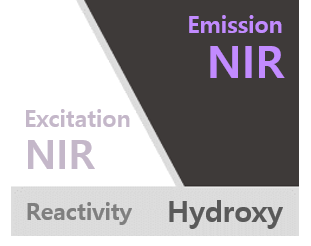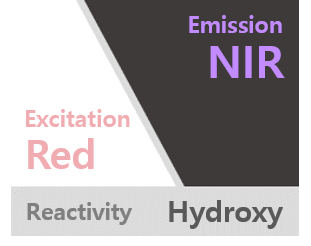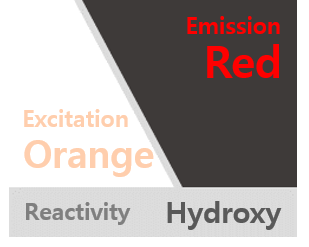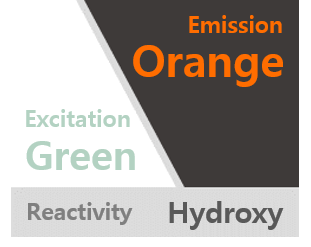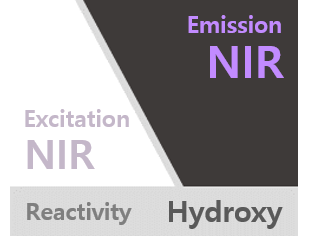
 >
Products
>
>
>
>
Products
>
>
>
- Flamma® Fluors NHS ester
- Flamma® Fluors Sulfo-NHS ester
- Flamma® Fluors Vinylsulfone
- Flamma® Fluors Isothiocyanate
- Flamma® Fluors Maleimide
- Flamma® Fluors Hydrazide
- Flamma® Fluors Dichlorotriazine
- Flamma® Fluors Carboxylic acid
- Flamma® Fluors Amine
- Flamma® Fluors Thiol
- Flamma® Fluors Alkyne
- Flamma® Fluors PEG4-Alkyne
- Flamma® Fluors ADIBO
- Flamma® Fluors Azide
Flamma® 581 Dichlorotriazine
| PACKING UNIT | price |
Lead time |
|---|---|---|
| 1 mg | $480.00 | |
| 5 mg | $1,740.00 | |
| 25 mg | $6,460.00 |
Description
Flamma® Fluors 581 Dichlorotriazine is a hydroxyl reactive orange fluorescent dye induced from benzindocyanine structure and used to generate a stable fluorescence signal in bioimaging. The maxima of Ex/Em values are at 578/593 nm, similar to that of Alexa 594 and DyLight 594. Flamma 581 might be excited using 561, 568 or 578 nm laser lines and displays excellent optical property. Hydroxyls irreversibly displace one of chlorines at triazine ring to yield an aryl ether linkage. Dichlorotriazines are among the few reactive groups that are reported to react directly with polysaccharides and other alcohols in aqueous solution, provided that the pH is >9 and other nucleophiles are not present. We offer Flamma Fluors 581 dichlorotriazine for labeling of polysaccharides and alcohols on biomolecules for cellular labeling and detection.
Citation & Reference
1. Ma N, A novel sulfated Mannan-carboxymethyl-5-fluorouracil-folic acid conjugates for targeted anticancer drug delivery. Carbohydrate Polymers. 2023 Mar;304:120454.
2. Kim CH, Self-immolative nanosensitizer for glutathione depletion- assisted sonodynamic therapy. Theranostics. 2022;12(17):7465–75.
3. Revuri V, In situ oxygenic nanopods targeting tumor adaption to hypoxia potentiate image-guided photothermal therapy. ACS Applied Materials & Interfaces. 2019 May 15;11(22):19782–92.
4. Yhee, Ji Young. Cancer-targeted MDR-1 siRNA delivery using self-cross-linked glycol chitosan nanoparticles to overcome drug resistance. Journal of Controlled Release 198 (2015): 1-9.
5. Yoon, Hong Yeol. Glycol chitosan nanoparticles as specialized cancer therapeutic vehicles: Sequential delivery of doxorubicin and Bcl-2 siRNA. Scientific reports 4 (2014).
6. Hollis, Christin P. In vivo investigation of hybrid paclitaxel nanocrystals with dual fluorescent probes for cancer theranostics. Pharmaceutical research 31.6 (2014): 1450-1459.
7. Oh, Keun Sang. Accurate sequential detection of primary tumor and metastatic lymphatics using a temperature-induced phase transition nanoparticulate system. International journal of nanomedicine 9 (2014): 2955.
8. Park, Jin Woo. Wide-Ranged Fluorescent Molecular Weight Size Markers for Electrophoresis. Bulletin of the Korean Chemical Society 34.1 (2013): 29-30.
9. Yoon, Hong Yeol. Bioreducible hyaluronic acid conjugates as siRNA carrier for tumor targeting. Journal of Controlled Release 172.3 (2013): 653-661.
10. Yhee, Ji Young. Tumor-targeting transferrin nanoparticles for systemic polymerized siRNA delivery in tumor-bearing mice. Bioconjugate chemistry 24.11 (2013): 1850-1860.
11. Koo, Heebeom. The movement of self-assembled amphiphilic polymeric nanoparticles in the vitreous and retina after intravitreal injection. Biomaterials 33.12 (2012): 3485-3493.
12. Zhu, Lei. Real-time monitoring of caspase cascade activation in living cells. Journal of controlled release 163.1 (2012): 55-62.
13. Huang, Xinglu. Multiplex Imaging of an Intracellular Proteolytic Cascade by using a Broad?Spectrum Nanoquencher. Angewandte Chemie International Edition 51.7 (2012): 1625-1630.
14. Ryu, Ju Hee. Early diagnosis of arthritis in mice with collagen?induced arthritis, using a fluorogenic matrix metalloproteinase 3–specific polymeric probe. Arthritis & Rheumatism 63.12 (2011): 3824-3832.
15. Ibrahim, Basma M. A strategy to deliver genes to cystic fibrosis lungs: a battle with environment. Journal of controlled release 155.2 (2011): 289-295.
16. Xu, Peisheng. Zwitterionic chitosan derivatives for pH-sensitive stealth coating. Biomacromolecules 11.9 (2010): 2352-2358.
OPTION
Total

 log
log My
My Contact
Contact
